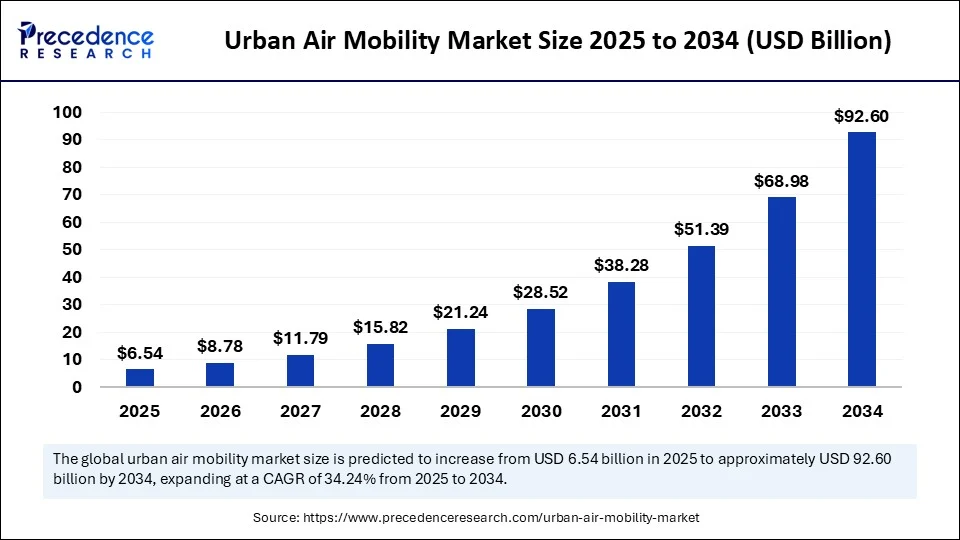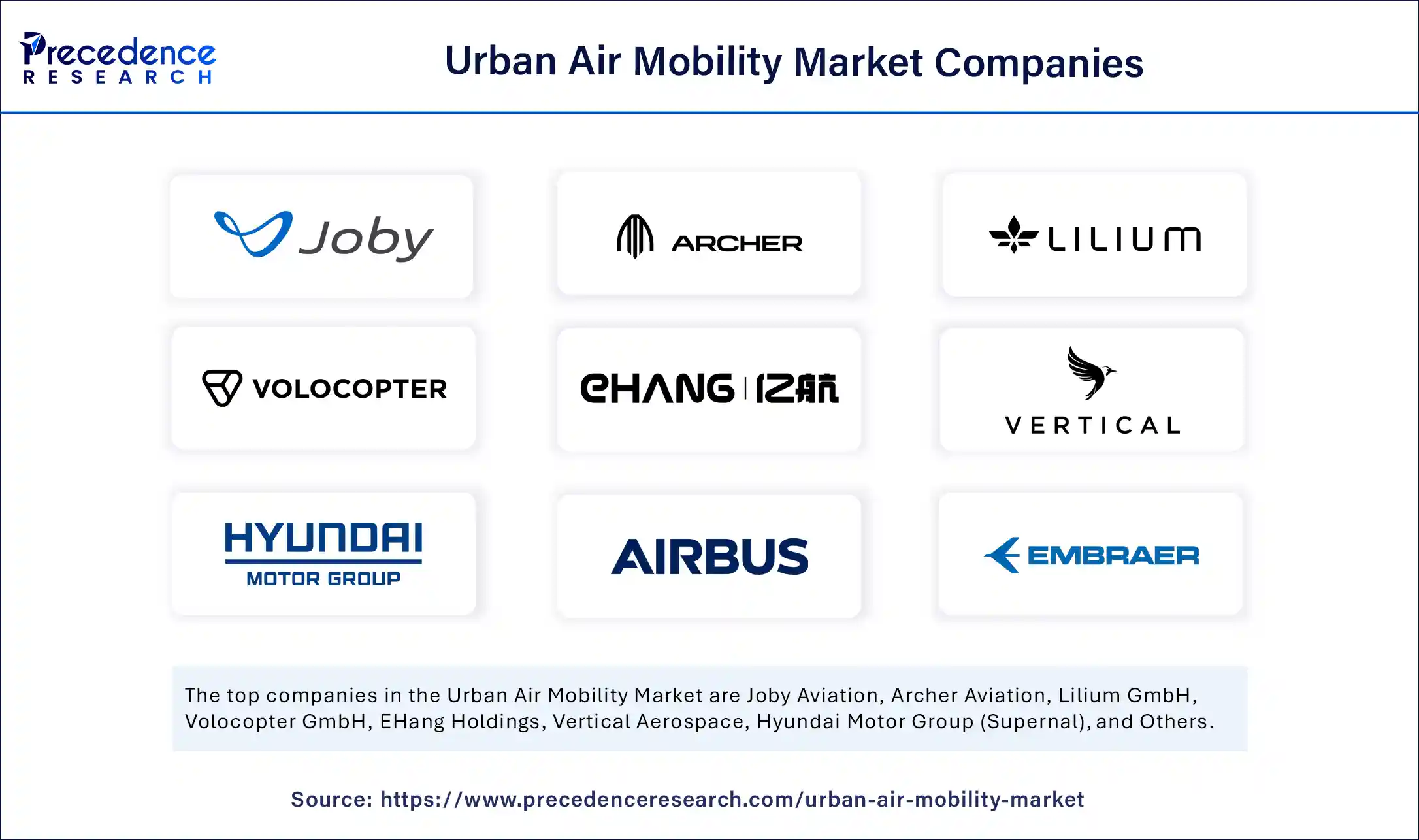The global urban air mobility (UAM) market is projected to skyrocket from USD 6.54 billion in 2025 to approximately USD 92.60 billion by 2034, expanding at a robust CAGR of 34.24% during this period. This rapid growth is fueled by increasing urban congestion, technological breakthroughs in electric vertical take-off and landing (eVTOL) aircraft, and AI-powered operational efficiencies, promising to revolutionize urban transportation worldwide.

What are the Key Drivers Behind Urban Air Mobility’s Astounding Growth?
The urban air mobility market finds its roots in mounting urban congestion and pollution, compelling cities to seek faster, cleaner aerial transport. Innovations in electric and hydrogen propulsion address sustainability concerns, while AI integration enhances safety, navigation, and traffic management. Strong investments by aerospace firms, tech companies, and governments, particularly in North America and Asia Pacific, accelerate development and adoption.
Urban Air Mobility Market Key Insights
-
The UAM market was valued at USD 4.87 billion in 2024 and is forecasted to hit USD 92.60 billion by 2034.
-
North America leads the market with a USD 1.36 billion size in 2024 and strong regulatory and investment support.
-
Asia Pacific is the fastest-growing region, driven by rapid urbanization and government initiatives.
-
Air taxis dominate as the preferred vehicle type, promising quick, point-to-point urban connectivity.
-
Piloted operation remains predominant, balancing safety and innovation pending full automation maturity.
-
Electric propulsion is the technology leader, aligning with global sustainability goals.
Urban Air Mobility Market Revenue Breakdown
| Year | Market Size (USD Billion) |
|---|---|
| 2024 | 4.87 |
| 2025 | 6.54 |
| 2034 | 92.60 |
Artificial intelligence is central to advancing UAM by enabling autonomous or semi-autonomous flight operations, optimizing flight paths, and ensuring seamless navigation in dense urban airspaces. AI systems support predictive analytics and real-time air traffic management, reducing energy consumption and minimizing delays, thereby enhancing operational reliability and scalability. The integration of AI-driven navigation systems is pivotal in evolving urban aerial transportation towards fully autonomous, efficient networks.
What Factors Are Accelerating Market Growth?
Factors propelling UAM growth include rapid urbanization leading to ground traffic congestion, government policies favoring sustainable transportation, continuous technological advancements in eVTOL and battery technologies, and significant investments from private and public sectors. Additionally, the growing emphasis on smart city initiatives encourages infrastructure development such as vertiports and charging stations, fostering ecosystem readiness for widespread adoption.
What Opportunities and Trends Could Shape the Future of UAM?
Could expanded logistics and emergency services accelerate urban air mobility adoption? Beyond passenger transport, UAM holds potential in time-critical logistics, medical emergency response, disaster relief, luxury tourism, and intercity connectivity. Emerging economies with rising urban populations offer untapped markets for aerial mobility. Will advancing AI and electric propulsion technologies unlock new operational efficiencies and cost reductions? Industry focus on hydrogen fuel cells and autonomous systems signals transformative trends likely to redefine urban mobility landscapes.
How Does Regional and Segment Analysis Shape Market Dynamics?
North America Leads Urban Air Mobility Innovation and Market Size
North America’s urban air mobility market is the largest globally, holding about 40% market share in 2024, driven by strong investment from aerospace giants, technology firms, and venture capital. The U.S. enjoys a robust ecosystem with regulatory support from the Federal Aviation Administration (FAA) crafting frameworks that balance safety with innovation. Major urban centers such as Los Angeles, New York, and Dallas are at the forefront of early adoption and pilot projects.
Public-private partnerships further accelerate infrastructure development and technology commercialization. The strong presence of electric aircraft manufacturers and AI-driven technology companies bolster regional growth, making North America a global hub for UAM advancements and market readiness.
Asia Pacific Booms as the Fastest-Growing Regional Market
Asia Pacific is emerging as the fastest-growing UAM market with a CAGR exceeding 34%, propelled by rapid urbanization, megacity congestion, and increasing demand for innovative mobility solutions. Countries like Japan, South Korea, Singapore, China, and India are actively supporting UAM development through government policies, investments, and partnerships with global aerospace leaders.
The region benefits from strong manufacturing capabilities and technological innovation, especially in electric propulsion and AI systems integration. Rapid growth is also driven by smart city initiatives, fostering infrastructure like vertiports and charging stations.
Europe, Latin America, and Middle East & Africa Showing Strong Market Development
Europe accounts for a significant portion of the global UAM market, driven by advanced regulatory frameworks promoting sustainability and technology adoption. Countries like Germany, France, and the U.K. invest heavily in eVTOL aircraft, pilot projects, and smart urban infrastructure,
Urban Air Mobility Market Segment Analysis: Vehicle Types, Operations, Propulsion, Range, Infrastructure, and End-Use
-
Vehicle Type: Air taxis, often in the form of eVTOL aircraft, dominate the UAM market by offering on-demand, point-to-point urban transportation, helping reduce traffic congestion and emissions.
-
Operation Mode: Piloted operation is currently the most prevalent, seen as safer and more reliable while autonomous technology matures. Companies conduct extensive testing of pilot-assisted and autonomous models to balance innovation and safety.
-
Propulsion Type: Electric propulsion leads technological adoption due to its environmental benefits and operational cost advantages. Distributed Electric Propulsion (DEP) technology, which uses multiple independent electric rotors, is key to achieving safety, noise reduction, and reliability in urban settings. Hydrogen fuel cells are explored but face storage challenges in urban environments.
-
Range: Intracity flights are the most popular, providing efficient transport within metropolitan areas. The focus is on optimizing flight routes and turnaround times with supporting charging infrastructure.
-
Infrastructure: Vertiports, dedicated takeoff and landing sites, are the largest infrastructure segment supporting UAM operations, facilitating efficient passenger boarding and aircraft charging. Charging stations are expanding rapidly as most UAM vehicles rely on electric power. Air traffic management and communication systems are being developed for safe integration with existing airspace.
-
End-Use Applications: UAM spans ride-sharing, air taxis, emergency medical services (air ambulances), delivery logistics, and emergency response. The diversity of applications is a key opportunity for market expansion.
What Are the Latest Breakthroughs and Leading Market Players?
Leading companies spearheading UAM innovations include Volocopter, Lilium, Urban Aeronautics, Joby Aviation, and EHang. Recent advances are seen in compact passenger drones and scalable air taxi fleets. Collaborations with tech firms enables AI integration and infrastructure expansion. Governments and industry leaders continue pilot projects and regulatory developments to facilitate commercialization.
Urban Air Mobility Market Companies

- Joby Aviation
- Archer Aviation
- Lilium GmbH
- Volocopter GmbH
- EHang Holdings
- Vertical Aerospace
- Hyundai Motor Group (Supernal)
- Boeing (Wisk Aero)
- Airbus SE
- Embraer (Eve Air Mobility)
- Bell Textron Inc.
- Beta Technologies
- Pipistrel (Textron eAviation)
- Kitty Hawk (Heaviside project)
- SkyDrive Inc.
- Autoflight
- Ascendance Flight Technologies
- Jaunt Air Mobility
- Electra Aero
- XTI Aircraft
What Challenges and Cost Pressures Does UAM Face?
Regulatory complexity regarding air traffic and safety, high initial development and certification costs, public acceptance concerns, and technological hurdles in energy storage and cybersecurity present notable challenges. Battery endurance and payload limitations demand ongoing innovation. Balancing cost with safety and scalability remains critical for market expansion.
Read Also: Military 3D Printing Market
Get this report to explore global market size, share, CAGR, and trends, featuring detailed segmental analysis and an insightful competitive landscape overview @ https://www.precedenceresearch.com/sample/6718
You can place an order or ask any questions. Please feel free to contact us at sales@precedenceresearch.com |+1 804 441 9344
- Powder Bonding 3D Printing Construction Market Build complex formwork with precision, customization, and sustainable design - September 9, 2025
- Protein Characterization and Identification Market Set to Reach USD 8.04 Billion by 2034 Fueled by 5.29% CAGR and AI-Driven Innovations - September 9, 2025
- Automotive Simulation Software Market Size to Cross USD 24.35 Billion by 2034 - September 8, 2025
